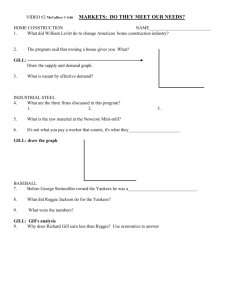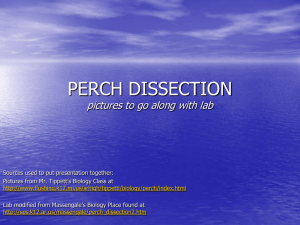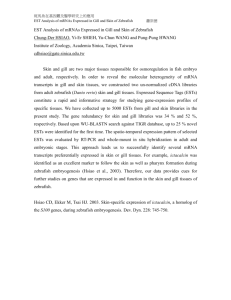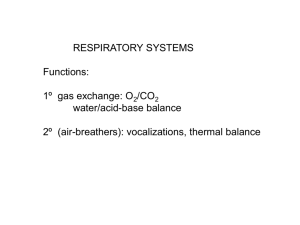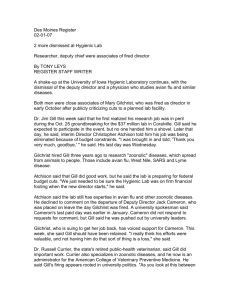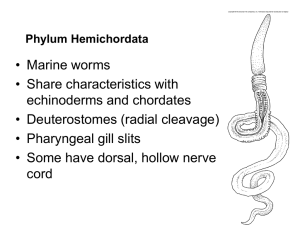NORMAL GILL FORM AND FUNCTION
advertisement
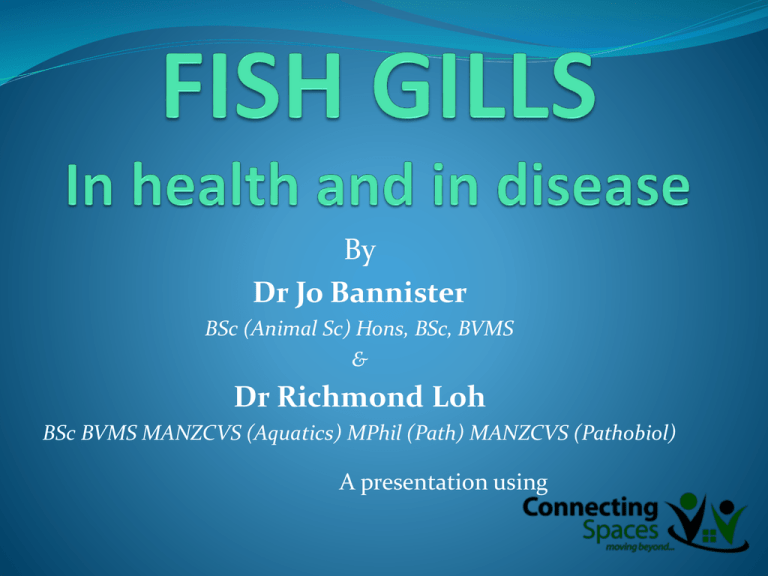
By Dr Jo Bannister BSc (Animal Sc) Hons, BSc, BVMS & Dr Richmond Loh BSc BVMS MANZCVS (Aquatics) MPhil (Path) MANZCVS (Pathobiol) A presentation using NORMAL GILL FORM AND FUNCTION Normal Teleost gill form (anatomy) • • ‘Branchia’ in greek = ‘gills’ In bony fish (Teleosts): • Gills lie in a branchial cavity covered by the operculum: • • Usually two sets of four holobranchs Each holobranch consists of two hemibranchs (‘half gill’): • • • Anterior and posterior Hemibranchs consist of a row of long filaments (primary lamellae) with semilunar folds (secondary lamellae). Lamellae or filaments: • • Connective tissue scaffold (epithelial cells) framing a vascular network providing blood flow primarily used for gas and ion exchange. Primary and secondary. Teleost gill structure Holobranch Gill filaments Hemibranch (anterior) Schematic of the teleost fish gill. Adapted from Evans et al. (2005) Gill lamellae Secondary lamellae Primary lamellae Retrieved from the World Wide Web (October 2012) http://www.biology-resources.com/drawing-fish-gillfilaments.html Normal Teleost gill function (physiology) Gill functions: • Gaseous exchange = O2 via 2o lamellae. • Acid-base balance = equilibrium between acidity/alkalinity. • Osmoregulation = adjustment of internal osmotic pressure in relation to surrounding medium. • • Excretion of nitrogenous waste = ammonia. Gills sensitive to a range of environmental pollutants. Gaseous exchange = secondary lamellae: • Consist of an envelope of epithelial cells • Usually one layer thick • Supported/separated by specialised cells: • • Pillar cells = regulate blood flow. Chloride cells = maintain internal ionic homeostasis. Normal gill histology Head end Parasagittal section of the buccal cavity through the gill arches (Bouins, H&E, Bar = 440 µm = ~ 4x magnification). Retrieved from the World Wide Web August 2012: http://aquaticpath.umd.edu/fhm/resp.html Normal gill histology Gill arch: sagittal section (Bouins, H&E, Bar = 90.2 µm = ~ 20x magnification). Retrieved from the World Wide Web August 2012: http://aquaticpath.umd.edu/fhm/resp.html Normal gill histology Gill filament, sagittal section through venous sinus (Formalin, H&E, Bar = 16.7 µm = >40x magnification). Retrieved from the World Wide Web August 2012: http://aquaticpath.umd.edu/fhm/resp.html References • Deeds, J.R., Reimschuessel, R. and Place, A.R. (2006). Histopathological Effects in Fish Exposed to the Toxins from Karlodinium micrum. Journal of Aquatic Animal Health. 18(2), 136-148. • Evans, D.H., Piermarini, P.M. and Choe, K.P. (2005). The Multifunctional Fish Gill: Dominant Site of Gas Exchange, Osmoregulation, Acid-Base Regulation, and Excretion of Nitrogenous Waste. Physiological Review: 85, 97–177. • Hallegraeff, G., Mooney, B. and Evans, K. (2010). What triggers Fish-Killing Karlodinium veneficum Dinoflagellate Blooms in the Swan Canning River System?. Swan Canning Research and Innovation Program. • H.W. Ferguson. (2006). Systemic pathology of fish. A Text and Atlas of Normal Tissues in Teleosts and their Responses in Disease. Scotian Press, London. • McGavin, M.D. and Zachary, J.F. (2007). Pathological basis of Veterinary Disease. 4th Ed. Mosby Elsevier, Miissouri. • Roberts. R.J. (1989). Fish Pathology. 2nd Ed. W.B. Saunders, London. • University of Maryland College Park Campus, Aquatic Pathobiology Centre, Virginia-Maryland Regional College of Veterinary Medicine, Atlas of Flathead Minnow Normal Histology. Retreived from the World Wide Web August 2012: http://aquaticpath.umd.edu/fhm/resp.html
